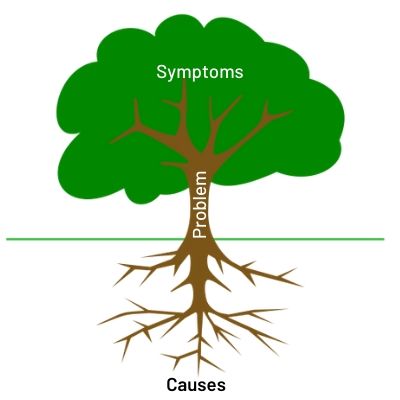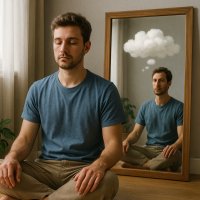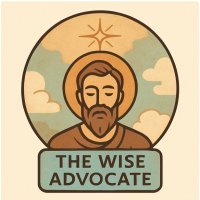Root Cause Analysis
Establishing The Issue That Lies Beneath A Presenting Problem

Root Cause Analysis - Overview
The mental model of root cause analysis involves establishing the issue that lies beneath a presenting problem.
Often the true underlying root issue is not immediately apparent and is only uncovered with persistent investigation.
Applying Root Cause Analysis
Root cause analysis can be applied in many different contexts.These tend to fall into 2 categories:
[1] Situational
The traditional application of this technique is situational and frequently in organisations and businesses where there has been a systemic, process or performance failure.
With this type of analysis the objective is to uncover the ultimate root cause and to identify the appropriate remedial action to prevent a re-occurrence .
There are various factors which we must take into
account when figuring out root causes.
- The location of the effect
- The exact nature of the effect
- The severity of the effect
- The time at which the effect occurs
- The level of vulnerability to the effect
- The cause of the effect
- The factors which prevented it from being more severe.
[2] Relational
The other - and frequently neglected - application is relational, that is to say uncovering the root underlying issue behind someone's behaviour and thus being able to understand them better and to provide the most resourceful response.
For example, I might say: "My partner has left me." The given reason will be something along the lines of: "She says she doesn't love me anymore".
But a deeper enquiry will reveal that in fact she has feels that I am controlling and do not allow her enough space.
A few weeks later, when she has an emotional and psychological breakdown and seeks professional help, it becomes apparent that she has deep-seated issues going back to her childhood when she was physically abused by her uncle who used to beat her with a belt.
The "solution" in this situation could be for me to let her know that I still love her and I am "holding a space" for her while she heals. This basically means that rather than angrily trying to deal with the many presenting issues that accompany a relationship breakdown I let her know that I am giving her as much space as she needs while she heals and that I hold no expectations.
This will require a high level of emotional maturity on my part but ultimately will allow for us both to heal and move on, either together in a renewed relationship or separately.
Establishing Root Causes
This is where we apply some of our thinking skills and employ mental models.
First Principles Thinking whereby you reduce the situation down to the most basic parts that you know are true. This involves removing all assumptions and digging deeper and deeper than most people will until you are left with only the foundation truth of a situation.
Shane Parrish suggests you can follow these steps:
- Clarifying thinking and explaining origins of ideas. (What happened? What do I think caused it?)
- Challenging assumptions. (How do I know this is the cause? What could have caused that cause)
- Looking for evidence. (How do I know that was the cause? What can I do to prove or disprove my ideas?)
- Considering alternative perspectives. (What might others think? What are all the potential causes? )
- Examining consequences and implications. (What are the consequences of the causes I have established? How can they help me solve problems?)
- Questioning the original questions. (What can I do differently now that I know the root cause? How will this help me?)
Another mental model that can be applied is Second Order Thinking which is about going beyond the obvious and avoiding unintended consequences. This involves questioning everything, not making assumptions, and when exploring possible solutions, always asking "What happens then?" and "Why?".
A variation of this is the "5 Whys" technique, which necessitates asking ‘Why?’ five times to a given statement. The purpose is to understand cause and effect relationships, leading to the root causes. Five is generally the necessary number of repetitions required. Each question is based on the previous answer, not the initial statement.
Using the example of a laid off employee we can see how this technique works - Shane Parrish again:
- Effect: I lost my job.
- Why? Because I was not valuable enough to the company and they could let me go without it causing any problems.
- Why? Because a newer employee in my department was getting far more done and having more creative ideas than me.
- Why? Because I had allowed my learning to stagnate and stopped keeping up with industry developments. I continued doing what I have for years because I thought it was effective.
- Why? Because I only received encouraging feedback from people higher up in the company, and even when I knew my work was substandard, they avoided mentioning it.
- Why? Because whenever I received negative feedback in the past, I got angry and defensive. After a few occurrences of this, I was left to keep doing work which was not of much use. Then, when the company began to experience financial difficulties, firing me was the practical choice.
- Solution: In future jobs, I must learn to be responsive to feedback, aim to keep learning and make myself valuable. I can also request regular updates on my performance. To avoid becoming angry when I receive negative feedback, I can try meditating during breaks to stay calmer at work.
Other mental models that can be usefully employed in root cause analysis are:
- Occams Razor which states that the best explanation is the one that requires you to make the fewest possible assumptions about what's involved.
- Probabilistic Thinking which is essentially about trying to estimate, using some tools of math and logic, the likelihood of any specific outcome coming to pass.
Return from "Root Cause Analysis" to Mental Models
LATEST ARTICLES
Staying Committed When You Can't See Progress - The Psychology of Grit
 Uncertainty Is Not The Absence Of Progress, Only The Absence Of Reassurance. One of the most destabilising experiences in modern life is not failure, but uncertainty and staying committed when you can…
Uncertainty Is Not The Absence Of Progress, Only The Absence Of Reassurance. One of the most destabilising experiences in modern life is not failure, but uncertainty and staying committed when you can…The Battle For Your Mind - How To Win Inner Freedom In A Digital Age Of Distraction
 From External Events to Inner Events. We often think of “events” as things that happen out there: the traffic jam, the rude comment, the delayed email reply. But what truly shapes our experience is wh…
From External Events to Inner Events. We often think of “events” as things that happen out there: the traffic jam, the rude comment, the delayed email reply. But what truly shapes our experience is wh…How to See Your Thoughts Without Becoming the Story
 A Practical Guide to Thought-Awareness. You can spend your life inside the stories of your mind without ever learning how to see your thoughts clearly and objectively. Most of the stuff we tell oursel…
A Practical Guide to Thought-Awareness. You can spend your life inside the stories of your mind without ever learning how to see your thoughts clearly and objectively. Most of the stuff we tell oursel…The Collison Decision Matrix - A Simple Framework for Better Choices
 The Collison Decision Matrix Is A Practical Everyday Thinking Tool. Most of us spend a surprising amount of time worrying about decisions. From small ones such as what to wear, what to eat, what to te…
The Collison Decision Matrix Is A Practical Everyday Thinking Tool. Most of us spend a surprising amount of time worrying about decisions. From small ones such as what to wear, what to eat, what to te…The Power Of Asking The Right Question
 The Power Of Asking The Right Question Lies In The Quest For Insight. To experience the power of asking the right question you must develop the practice of asking questions. The best way to improve th…
The Power Of Asking The Right Question Lies In The Quest For Insight. To experience the power of asking the right question you must develop the practice of asking questions. The best way to improve th…Site Pathways
 Here is a site pathway to help new readers of Zen-Tools navigate the material on this site. Each pathway is based around one of the many key themes covered on this site and contain a 150 word introduc…
Here is a site pathway to help new readers of Zen-Tools navigate the material on this site. Each pathway is based around one of the many key themes covered on this site and contain a 150 word introduc…How To Live With Contradiction - Beyond Thought Let Stillness Speak
 A major impact on so many peoples' lives is the situational contradiction of unfilled realistic expectations. So where does all this leave us? Well here we are, with mental equipment that is more lim…
A major impact on so many peoples' lives is the situational contradiction of unfilled realistic expectations. So where does all this leave us? Well here we are, with mental equipment that is more lim…How To Trust The Process Of Mindfulness - Right Now
 In mindfulness, the process isn’t some distant goal — it's what is happening right now. When we talk about how to trust the process of mindfulness the credibility of the process is heavily dependent…
In mindfulness, the process isn’t some distant goal — it's what is happening right now. When we talk about how to trust the process of mindfulness the credibility of the process is heavily dependent…Inner Mastery For Outer Impact - Mental Clarity For Effective Action
 Insights only matter if they translate into consistent action. In a world crowded with quick fixes and motivational soundbites, the theme “Inner Mastery for Outer Impact” calls us to something more e…
Insights only matter if they translate into consistent action. In a world crowded with quick fixes and motivational soundbites, the theme “Inner Mastery for Outer Impact” calls us to something more e…The Wise Advocate - Helping You Achieve The Very Best Outcome
 The focus of your attention in critical moments of choice either builds or restricts your capacity for achieving the best outcome. When we talk of 'The Wise Advocate' its easy to think of the consigl…
The focus of your attention in critical moments of choice either builds or restricts your capacity for achieving the best outcome. When we talk of 'The Wise Advocate' its easy to think of the consigl…Trust The Process - Beyond The Cliche
 The phrase "trust the process" has become a cliche, the woo-woo mantra of the "self help" industry. Those three little words feel like they ought to mean something useful but hidden behind them are a…
The phrase "trust the process" has become a cliche, the woo-woo mantra of the "self help" industry. Those three little words feel like they ought to mean something useful but hidden behind them are a…The Dopamine Delusion - Why Anticipation Beats Achievement
 The thrill we feel is not in the having, but in the wanting. The more we have, the more we want. The more things we acquire and the easier things get for us, the more discontent we feel. The more spo…
The thrill we feel is not in the having, but in the wanting. The more we have, the more we want. The more things we acquire and the easier things get for us, the more discontent we feel. The more spo…